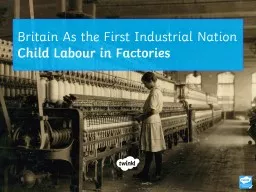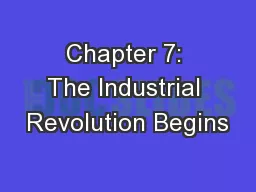PPT-Britain As the First Industrial Nation
Author : ZestyZenMaster | Published Date : 2022-07-28
Child Labour in Factories To explain what child labour is and how it played a part in the Industrial Revolution To analyse the effects of the Factory Act of 1833
Presentation Embed Code
Download Presentation
Download Presentation The PPT/PDF document "Britain As the First Industrial Nation" is the property of its rightful owner. Permission is granted to download and print the materials on this website for personal, non-commercial use only, and to display it on your personal computer provided you do not modify the materials and that you retain all copyright notices contained in the materials. By downloading content from our website, you accept the terms of this agreement.
Britain As the First Industrial Nation: Transcript
Download Rules Of Document
"Britain As the First Industrial Nation"The content belongs to its owner. You may download and print it for personal use, without modification, and keep all copyright notices. By downloading, you agree to these terms.
Related Documents














